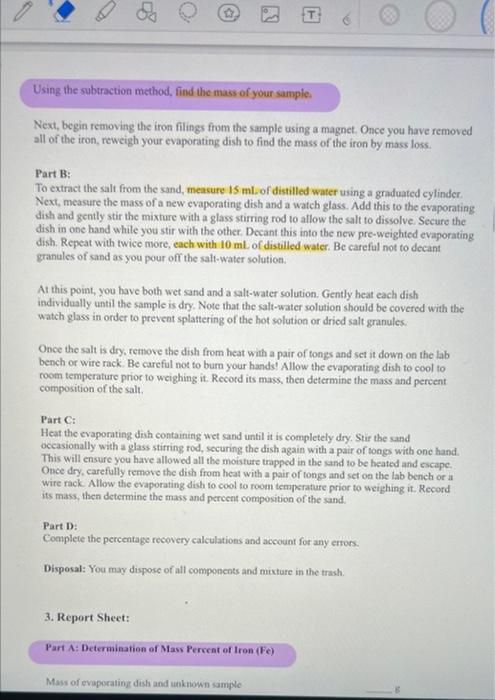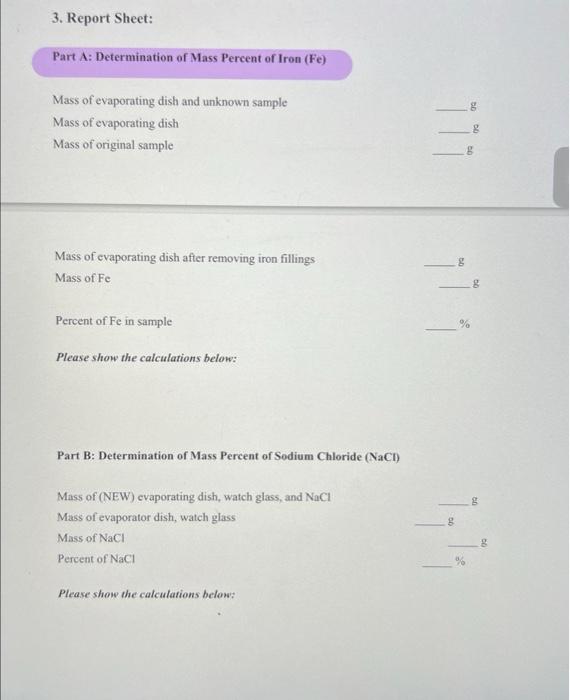Answered step by step
Verified Expert Solution
Question
1 Approved Answer
3. report sheet part B through D show calvulations thabk you Using the subtraction method, find the mass of your sample. Next, begin removing the
3. report sheet
Using the subtraction method, find the mass of your sample. Next, begin removing the iron filings from the sample using a magnet. Once you have removed all of the iron, reweigh your evaporating dish to find the mass of the iron by mass loss. Part B: To extract the salt from the sand, measure 15mL of distilled water using a graduated cylinder. Next, measure the mass of a new evaporating dish and a watch glass. Add this to the evaporating dish and gently stir the mixture with a glass stirring rod to allow the salt to dissolve. Secure the dish in one hand while you stir with the other. Decant this into the new pre-weighted evaporating dish. Repeat with twice more, each with 10mL. of distilled water. Be careful not to decant granules of sand as you pour off the salt-water solution. At this point, you have both wet sand and a salt-water solution. Gently heat each dish individually until the sample is dry. Note that the salt-water solution should be covered with the watch glass in order to prevent splattering of the hot solution or dried salt granules. Once the salt is dry, remove the dish from heat with a pair of tongs and set it down on the lab bench or wire rack. Be careful not to burn your hands! Allow the evaporating dish to cool to room temperature prior to weighing it. Record its mass, then determine the mass and percent composition of the salt. Part C: Heat the evaporating dish containing wet sand until it is completely dry. Stir the sand oceasionally with a glass stirring rod, securing the dish again with a pair of tongs with one hand. This will ensure you have allowed all the moisture trapped in the sand to be heated and escape. Once dry, carefully temove the dish from heat with a pair of tongs and set on the lab bench or a wire rack. Allow the evaporating dish to cool to room temperature prior to weighing it. Record its mass, then determine the mass and percent composition of the sand. Part D: Complete the percentage recovery calculations and account for any enron. Disposal: You may dispore of all components and mixture in the trash. 3. Report Sheet: 3. Report Sheet: Mass of evaporating dish and unknown sample g Mass of evaporating dish g Mass of original sample g Mass of evaporating dish after removing iron fillings g Mass of Fe g Percent of Fe in sample % Please show the calculations below: Part B: Determination of Mass Percent of Sodium Chloride (NaCI) Mass of (NEW) evaporating dish, watch glass, and NaCl Mass of evaporator dish, watch glass g Mass of NaCl Percent of NaCl g Please show the calculations below: Part C: Determination of Mass Percent of Silicon dioxide (SiO2) 1 Mass of evaporating dish and SiO2 g 2 Mass of evaporating dish g 3 Mass of SiO2 4 Percent of SiO2 g Please show the calculations below: Part D: Determination of Percent Recovery Mass of original sample (from Part A) g Mass determined ( Fe+NaCl+SiO2 recovered) g Percent recovered % Please show the calculations below: Using the subtraction method, find the mass of your sample. Next, begin removing the iron filings from the sample using a magnet. Once you have removed all of the iron, reweigh your evaporating dish to find the mass of the iron by mass loss. Part B: To extract the salt from the sand, measure 15mL of distilled water using a graduated cylinder. Next, measure the mass of a new evaporating dish and a watch glass. Add this to the evaporating dish and gently stir the mixture with a glass stirring rod to allow the salt to dissolve. Secure the dish in one hand while you stir with the other. Decant this into the new pre-weighted evaporating dish. Repeat with twice more, each with 10mL. of distilled water. Be careful not to decant granules of sand as you pour off the salt-water solution. At this point, you have both wet sand and a salt-water solution. Gently heat each dish individually until the sample is dry. Note that the salt-water solution should be covered with the watch glass in order to prevent splattering of the hot solution or dried salt granules. Once the salt is dry, remove the dish from heat with a pair of tongs and set it down on the lab bench or wire rack. Be careful not to burn your hands! Allow the evaporating dish to cool to room temperature prior to weighing it. Record its mass, then determine the mass and percent composition of the salt. Part C: Heat the evaporating dish containing wet sand until it is completely dry. Stir the sand oceasionally with a glass stirring rod, securing the dish again with a pair of tongs with one hand. This will ensure you have allowed all the moisture trapped in the sand to be heated and escape. Once dry, carefully temove the dish from heat with a pair of tongs and set on the lab bench or a wire rack. Allow the evaporating dish to cool to room temperature prior to weighing it. Record its mass, then determine the mass and percent composition of the sand. Part D: Complete the percentage recovery calculations and account for any enron. Disposal: You may dispore of all components and mixture in the trash. 3. Report Sheet: 3. Report Sheet: Mass of evaporating dish and unknown sample g Mass of evaporating dish g Mass of original sample g Mass of evaporating dish after removing iron fillings g Mass of Fe g Percent of Fe in sample % Please show the calculations below: Part B: Determination of Mass Percent of Sodium Chloride (NaCI) Mass of (NEW) evaporating dish, watch glass, and NaCl Mass of evaporator dish, watch glass g Mass of NaCl Percent of NaCl g Please show the calculations below: Part C: Determination of Mass Percent of Silicon dioxide (SiO2) 1 Mass of evaporating dish and SiO2 g 2 Mass of evaporating dish g 3 Mass of SiO2 4 Percent of SiO2 g Please show the calculations below: Part D: Determination of Percent Recovery Mass of original sample (from Part A) g Mass determined ( Fe+NaCl+SiO2 recovered) g Percent recovered % Please show the calculations below part B through D
show calvulations thabk you 





Step by Step Solution
There are 3 Steps involved in it
Step: 1

Get Instant Access to Expert-Tailored Solutions
See step-by-step solutions with expert insights and AI powered tools for academic success
Step: 2

Step: 3

Ace Your Homework with AI
Get the answers you need in no time with our AI-driven, step-by-step assistance
Get Started


